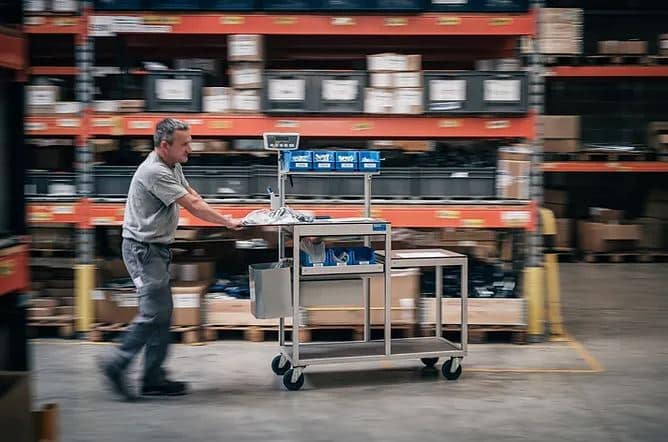The context and challenges of trolley 4.0
Logistics
4.0 solutions
Supply Chain
October 10, 2024

In the world of logistics, the trolley is a warehouse staple . It's used for storage, replenishment, picking, and order preparation. Today, it's an essential tool for moving and identifying merchandise.
Following technological developments over time, the shopping cart we all know has gradually transformed into a connected one in order to adapt to the market.
What is a 4.0 cart?
A 4.0 trolley is a connected trolley . This means that it incorporates a number of technologies capable of communicating.
Among these technologies, we can find:
- The Panel PC is equipped with a touchscreen,
- Put-to-light solutions for depositing items
- Cameras, allowing for example filming or taking a photo each time items are deposited in order to create a record,
- Weight control.
In addition to these examples, other technologies such as RFID, as well as all sorts of automated systems that need to be controlled, also come into play. For example, it is entirely possible to grant access at a specific time to a hatch or a package using a connector.
What is the connection with a WMS?
The forklift enhances productivity. Logically, a picker's performance in order preparation depends on the number of items they successfully pick along their route. Using a WMS (Warehouse Management System) allows the operator to optimize their route and reduce the distance between each pick . This reduction, in turn, leads to time savings and ultimately increased productivity.
How? The WMS software acts here as a creator of missions which will then be assigned to the order picker . In order to create these missions, the WMS first analyzes the data at its disposal (the orders concerned by a trolley preparation, the processing order, the urgency, the date, etc.) which it will cross-reference with the available resources (the authorization of the order pickers, the capacity of the trolley, etc.).
The WMS structures the flows and dynamically builds the missions allowing for a massification of the sampling.
The objectives of the 4.0 cart
The 4.0 cart can fulfill several objectives:
Error reduction
- Simple identification of the location where the goods should be placed,
- Quantity control via weight control,
- A touchscreen allows the operator to interact with the information available on the computer system…
Increased productivity
- Preparing more orders,
- Reducing the number of scans by removing the barcode from the carton, for example
- Reducing the number of checks by installing cameras that can take photos to verify the order status…
To make the operator's job easier
- An intuitive screen that allows you to work in better conditions,
- A high-performance work tool that makes the employee's daily tasks more pleasant…
This list of objectives is not exhaustive, and it is important to understand that logistics is very diverse . This is why there is not one, but several trolleys adapted to the size of the products, the logistical context, and the nature of the orders.
Goods to man and ultra-mechanization: the death of the carts?
Currently, we are experiencing an extremely interesting phase in logistics. In a majority of warehouses, we are seeing a proliferation of technologies being developed, tested and deployed throughout France, with a rush towards mechanization and Goods-to-Man solutions that can be very costly.
Ultimately, isn't the trolley a solution of the past? We are convinced that this tool still has a bright future. Goods-to-person can be a fantastic opportunity, but it must be implemented within a specific logistical framework to deliver a significant ROI .
The world of logistics is becoming increasingly sophisticated, and the logic behind the forklift is, and always will be, to keep pace with technological evolution in order to become ever more efficient. It will always have its place alongside Goods-to-Person solutions.
Ultimately, the most important thing is to find the right work tool for each operator based on their logistical context.
Most read articles
WMS software
Logistics
Supply Chain
October 31, 2025
Packaging optimization: How does your WMS save you money on transported "empty space"?
Empty space represents, on average, 57% of the volume of packages shipped in e-commerce. It's not just wasted space; it's money gone up in smoke. In this article, we'll analyze how a WMS platform can become the ultimate weapon against empty space.
WMS software
Logistics
Supply Chain
October 17, 2025
Mastering the last mile from the warehouse: The winning duo of WMS and TMS
The last mile is the final sprint, the last step in a product's journey. But it's also, by far, the most expensive, most complex, and most decisive step for the customer experience.
WMS software
Logistics
4.0 solutions
Supply Chain
November 21, 2025
Dynamic slotting: How your WMS uses AI to halve picking time
Logistics has never been so demanding. Between the proliferation of distribution channels, the explosion of e-commerce, and the constant pressure on delivery times, your warehouse performance is directly linked to the efficiency of your internal processes. This is where slotting (or space allocation) comes into play, going far beyond simple routine storage management.

















